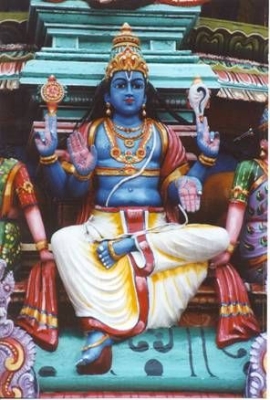



Image used with permission.
Basic Description: The Pervader, Preserver, Sustainer. He is the force that holds the universe together. He is the power by which things exist. He dwells in everything, owns everything and defeats the powers of destruction. Vishnu overcomes all things. Vishnu is often referred to in the context of the Hindu trinity alongside Brahma, the Creator, and Shiva, the "Destroyer. These three gods together create, sustain, and destroy the universe and all that is within it.
Alternate Names: Hari (Hara), the Remover; Narayana, Moving on the waters; or abode of man.
History/Practices: Followers and disciples of Vishnu are called Vaishnavites. They look to Vishnu or one of his incarnations for their salvation. He has 1000 names and the repetition of his names is an act of devotion done by his followers. He is worshipped primarily in the Ganges area. Vishnu remains in heaven and from there ensures the preservation of the universe. Therefore, he has not died and has never been born. He is in heaven waiting to incarnate himself one last time as a messianic figure.
Iconography: Vishnu is most commonly depicted sleeping on the coils of a serpent floating in the ocean, or standing, with four arms and in his four hands, a conch, discus, mace and a bow (or lotus). On his chest is the lock of hair Beloved-of-Fortune and a shining jewel Treasure-of-the-ocean. Vishnu is pictured with four arms, in each of his hands Vishnu holds one of his four attributes. Most frequently these attributes are: conch, discus, bow, mace.
Mythology: The following are myths about Vishnu:
Accomplishments and Character: Vishnu is the guardian and protector of dharma, the peaceful order of the creation. Whenever the world becomes chaotic Vishnu incarnates himself as an avatar in order to help humanity, thus giving him the name the Preserver. He is a sun god who took a mere three steps to cross the entire universe. These famous three steps symbolize the rising, apex, and setting of the sun.
The First Born: When the whole earth was covered with water and Vishnu was asleep at the breast of Devi, a lotus grew from his navel. A flower grew from the lotus and reached the top of the floodwaters; Brahma sprang from this flower. Brahma looked around and saw no other creature within the boundless expanse of the watery universe. He imagined himself to be the first born and therefore to have rank above all other future beings. He descended down the stalk of the flower to the lotus and there, found Vishnu asleep. Brahma asked loudly who he was; Vishnu responded, "I am the first born". Brahma denied this and therefore engaged in a battle against Vishnu. Suddenly before them appeared a lingam. The lingam went up as far as they could see and down as far as they could see. Together they decided to try and explore it. Vishnu became a boar and traveled down for a thousand years, but never found a base. Brahma became a goose and traveled up for a thousand years, but never found a top. They both returned to where they had started and the lingam became Shiva, thus proving that Shiva was the most powerful. Shiva then named Vishnu as the first born and punished Brahma for his pride by cutting off his fifth head.
Riding Animal: Vishnu is seen riding on a bird, half vulture, half man: Garuda, Wings of Speech. This bird represents the verbal utterances of the Vedas; the magic words - the wings - that allow man to be transported from one world into another.
Consort: Lakshmi, the goddess of fortune and beauty.
Other References on the Karma-to-Grace website:
- Is
there a savior in Hinduism?
- Hindu Trinity compared to Christian Trinity
.- Is the Trinity of Christianity and Hinduism the same
?- Vankateswami and the God of the Untouchables.
- Fire walker discovers his penance was paid.